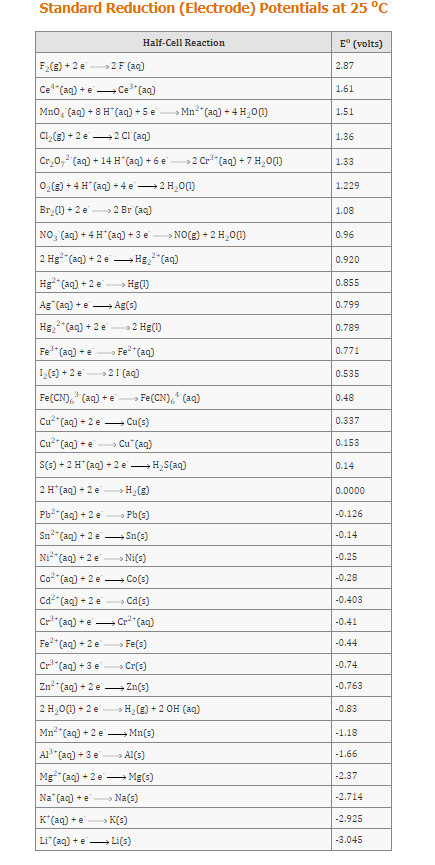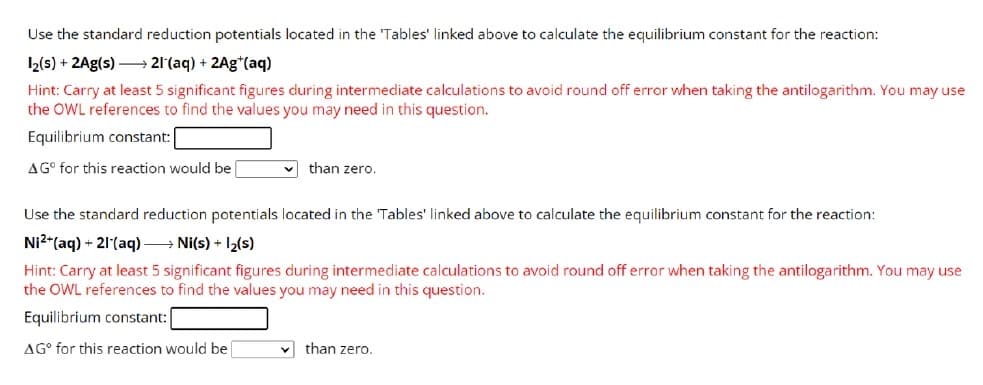Use the standard reduction potentials located in the 'Tables' linked above to calculate the equilibrium constant for the reaction: 1₂(s) + 2Ag(s)→→→→→→21 (aq) + 2Ag (aq) Hint: Carry at least 5 significant figures during intermediate calculations to avoid round off error when taking the antilogarithm. You may use the OWL references to find the values you may need in this question. Equilibrium constant: AGO for this reaction would be ✓than zero. Use the standard reduction potentials located in the Tables' linked above to calculate the equilibrium constant for the reaction: Ni²+ (aq) + 21 (aq) →→→→ Ni(s) + 1₂(s) Hint: Carry at least 5 significant figures during intermediate calculations to avoid round off error when taking the antilogarithm. You may use the OWL references to find the values you may need in this question. Equilibrium constant: AG for this reaction would be than zero.
Use the standard reduction potentials located in the 'Tables' linked above to calculate the equilibrium constant for the reaction: 1₂(s) + 2Ag(s)→→→→→→21 (aq) + 2Ag (aq) Hint: Carry at least 5 significant figures during intermediate calculations to avoid round off error when taking the antilogarithm. You may use the OWL references to find the values you may need in this question. Equilibrium constant: AGO for this reaction would be ✓than zero. Use the standard reduction potentials located in the Tables' linked above to calculate the equilibrium constant for the reaction: Ni²+ (aq) + 21 (aq) →→→→ Ni(s) + 1₂(s) Hint: Carry at least 5 significant figures during intermediate calculations to avoid round off error when taking the antilogarithm. You may use the OWL references to find the values you may need in this question. Equilibrium constant: AG for this reaction would be than zero.
Chemistry & Chemical Reactivity
10th Edition
ISBN:9781337399074
Author:John C. Kotz, Paul M. Treichel, John Townsend, David Treichel
Publisher:John C. Kotz, Paul M. Treichel, John Townsend, David Treichel
Chapter19: Principles Of Chemical Reactivity: Electron Transfer Reactions
Section19.9: Corrosion: Redox Reactions In The Environment
Problem 2.4ACP: The overall reaction for the production of Cu(OH)2 from Cu in oxygenated water can be broken into...
Related questions
Question
100%
Calculate K (both parts of the question)

Transcribed Image Text:Standard Reduction (Electrode) Potentials at 25 °C
Half-Cell Reaction
2 F (aq)
F₂(g) + 2 e
Ce¹(aq) + e
MnO₂ (aq) +8
Cl₂(g) + 2 e
Cr₂0₂² (aq) + 14 H(aq) + 6 e —> 2 Cr³(aq) + 7 H₂0 (1)
0₂(g) + 4 H (aq) + 4e → 2 H₂0 (1)
Br₂ (1) + 2 e
2 Br (aq)
NO₂ (aq) + 4 H*(aq) + 3 e° ——» NO(g) + 2 H₂0 (1)
2 Hg2+ (aq) + 2 eHg₂² (aq)
Ce³+ (aq)
H*(aq) +5 e
2 Cl'(aq)
Hg2+ (aq) + 2e Hg(1)
Ag (aq)+eAg(s)
Hg₂² (aq) +2 e →→→>2 Hg(!)
Fe³+(aq) +e →→→Fe²+ (aq)
1₂ (s) + 2 e →21 (aq)
Fe(CN),(aq) + e > Fe(CN),* (aq)
Cu²+ (aq) +2 e
Cu²+ (aq) +
S(s) + 2 H* (aq) + 2 H₂S(aq)
2 H*(aq) + 2e
Pb²+ (aq) + 2 e
Sn²(aq) + 2 e
Ni²+(aq) +2 e
Co²+ (aq) + 2
Cd²+ (aq) +2 e
Cr²³(aq) + e
Fe²+ (aq) + 2 e
Cr²³(aq) + 3 e
Zn²2(aq) + 2 e
2 H₂O(1) + 2 e
Cu(s)
Cu(aq)
H₂(g)
> Pb(s)
Sn(s)
→→Ni(s)
Mn²* (aq) + 4 H₂0 (1)
Co(s)
Cd (s)
Cr²2 (aq)
→→Fe(s)
→→Cr(s)
Zn(s)
> H₂(g) + 2 OH(aq)
Mn²(aq) + 2e
→→Mn(s)
A1³+ (aq) + 3 e
→→→→Al(s)
Mg2+ (aq) + 2 e Mg(s)
Na (aq) +eNa(s)
K* (aq) +e →→→K(s)
Li (aq) +eLi(s)
Eº (volts)
2.87
1.61
1.51
1.36
1.33
1.229
1.08
0.96
0.920
0.855
0.799
0.789
0.771
0.535
0.48
0.337
0.153
0.14
0.0000
-0.126
-0.14
-0.25
-0.28
-0.403
-0.41
-0.44
-0.74
-0.763
-0.83
-1.18
-1.66
-2.37
-2.714
-2.925
-3.045

Transcribed Image Text:Use the standard reduction potentials located in the 'Tables' linked above to calculate the equilibrium constant for the reaction:
1₂(s) + 2Ag(s)→→→→→21 (aq) + 2Ag+ (aq)
Hint: Carry at least 5 significant figures during intermediate calculations to avoid round off error when taking the antilogarithm. You may use
the OWL references to find the values you may need in this question.
Equilibrium constant:
AGO for this reaction would be
✓than zero.
Use the standard reduction potentials located in the 'Tables' linked above to calculate the equilibrium constant for the reaction:
Ni²+ (aq) + 21 (aq) →→→ Ni(s) + 1₂(s)
Hint: Carry at least 5 significant figures during intermediate calculations to avoid round off error when taking the antilogarithm. You may use
the OWL references to find the values you may need in this question.
Equilibrium constant:
AG for this reaction would be
✓than zero.
Expert Solution
This question has been solved!
Explore an expertly crafted, step-by-step solution for a thorough understanding of key concepts.
This is a popular solution!
Trending now
This is a popular solution!
Step by step
Solved in 4 steps with 5 images

Knowledge Booster
Learn more about
Need a deep-dive on the concept behind this application? Look no further. Learn more about this topic, chemistry and related others by exploring similar questions and additional content below.Recommended textbooks for you

Chemistry & Chemical Reactivity
Chemistry
ISBN:
9781337399074
Author:
John C. Kotz, Paul M. Treichel, John Townsend, David Treichel
Publisher:
Cengage Learning

Chemistry: An Atoms First Approach
Chemistry
ISBN:
9781305079243
Author:
Steven S. Zumdahl, Susan A. Zumdahl
Publisher:
Cengage Learning


Chemistry & Chemical Reactivity
Chemistry
ISBN:
9781337399074
Author:
John C. Kotz, Paul M. Treichel, John Townsend, David Treichel
Publisher:
Cengage Learning

Chemistry: An Atoms First Approach
Chemistry
ISBN:
9781305079243
Author:
Steven S. Zumdahl, Susan A. Zumdahl
Publisher:
Cengage Learning


Chemistry
Chemistry
ISBN:
9781305957404
Author:
Steven S. Zumdahl, Susan A. Zumdahl, Donald J. DeCoste
Publisher:
Cengage Learning

Chemistry by OpenStax (2015-05-04)
Chemistry
ISBN:
9781938168390
Author:
Klaus Theopold, Richard H Langley, Paul Flowers, William R. Robinson, Mark Blaser
Publisher:
OpenStax

Chemistry: Principles and Reactions
Chemistry
ISBN:
9781305079373
Author:
William L. Masterton, Cecile N. Hurley
Publisher:
Cengage Learning